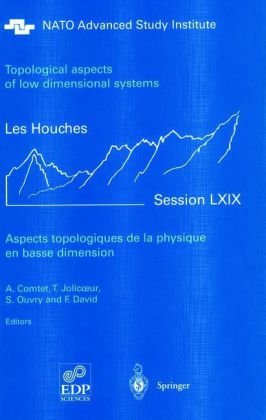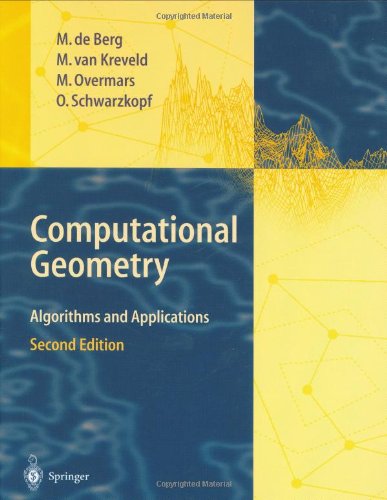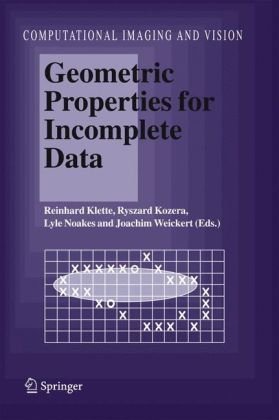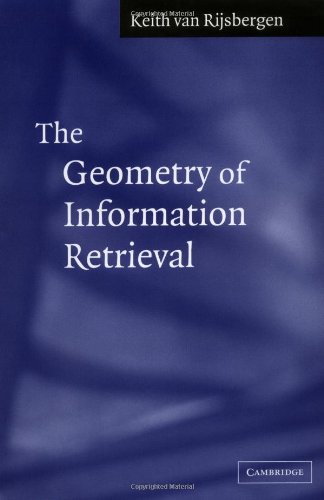A. Comtet, T. Jolicoeur, S. Ouvry, F. David9783540669098, 3540669094, 2868834248
Table of contents :
Course 14……Page 0
1 Introduction……Page 37
2.1 2D electrons at the GaAs/AlGaAs interface……Page 40
3.1 Shubnikov-de Haas oscillations and the IQHE……Page 44
3.2 FQHE and Wigner crystal……Page 46
4 CompositeFermions……Page 50
5 Ferromagnetic state at $nu=1$ and Skyrmions……Page 53
6.1 Overview……Page 55
6.2 Electron system in a wide, single, quantum well……Page 60
6.3 Evolution of the QHE states in a wide quantum well……Page 63
6.4 Evolution of insulating phases……Page 68
6.5 Many-body, bilayer QHE at $nu=1$……Page 75
6.6 Spontaneous interlayer charge transfer……Page 78
6.7 Summary……Page 82
References……Page 83
1.1 Introduction……Page 89
1.3 Constructing the 2DEG……Page 91
1.4 Why is disorder and localization important?……Page 92
1.5 Classical dynamics……Page 95
1.6 Semi-classical approximation……Page 98
1.7 Quantum Dynamics in Strong B Fields……Page 99
1.8 IQHE edge states……Page 106
1.9 Semiclassical percolation picture……Page 110
1.10 Fractional QHE……Page 114
1.11 The $nu = 1$ many-body state……Page 119
1.12 Neutral collective excitations……Page 128
1.13 Charged excitations……Page 138
1.14 FQHE edge states……Page 147
1.15 Quantum hall ferromagnets……Page 150
1.16 Coulomb exchange……Page 152
1.17 Spin wave excitations……Page 153
1.18 Effective action……Page 158
1.19 Topological excitations……Page 163
1.20 Skyrmion dynamics……Page 175
1.21 Skyrme lattices……Page 181
1.22 Double-layer quantum hall ferromagnets……Page 186
1.23 Pseudospin analogy……Page 188
1.24 Experimental background……Page 190
1.25 Interlayer phase coherence……Page 194
1.26 Interlayer tunneling and tilted field effects……Page 196
A Lowest Landau level projection……Page 199
B Berry’s phase and adiabatic transport……Page 202
References……Page 206
1 Introduction……Page 213
2.1 Chern-Simons coupled to matter fields – “anyons”……Page 216
2.2 Maxwell-Chern-Simons: Topologically massive gauge theory……Page 220
2.3 Fermions in 2 + 1-dimensions……Page 223
2.4 Discrete symmetries: $mathcal{P}$, $mathcal{C}$ and $mathcal{T}$……Page 224
2.5 Poincaré algebra in 2+ 1-dimensions……Page 226
2.6 Nonabelian Chern-Simons theories……Page 227
3.1 Canonical structure of Chern-Simons theories……Page 229
3.2 Chern-Simons quantum mechanics……Page 232
3.3 Canonical quantization of abelian Chern-Simons theories……Page 237
3.4 Quantization on the torus and magnetic translations……Page 239
3.5 Canonical quantization of nonabelian Chern-Simons theories……Page 242
3.6 Chern-Simons theories with boundary……Page 246
4.1 Abelian-Higgs model and Abrikosov-Nielsen-Olesen vortices……Page 248
4.2 Relativistic Chern-Simons vortices……Page 253
4.3 Nonabelian relativistic Chern-Simons vortices……Page 258
4.4 Nonrelativistic Chern-Simons vortices: Jackiw-Pi model……Page 259
4.5 Nonabelian nonrelativistic Chern-Simons vortices……Page 262
4.6 Vortices in the Zhang-Hansson-Kivelson model for FQHE……Page 265
4.7 Vortex dynamics……Page 268
5 Induced Chern-Simons terms……Page 271
5.1 Perturbatively induced Chern-Simons terms: Fermion loop……Page 272
5.2 Induced currents and Chern-Simons terms……Page 276
5.3 Induced Chern-Simons terms without fermions……Page 277
5.4 A finite temperature puzzle……Page 280
5.5 Quantum mechanical finite temperature model……Page 282
5.6 Exact finite temperature 2 + 1 effective actions……Page 287
5.7 Finite temperature perturbation theory and Chern-Simons terms……Page 290
References……Page 293
1 Introduction……Page 303
1.1 The concept of particle statistics……Page 304
1.2 Statistical mechanics and the many-body problem……Page 307
1.3 Experimental physics in two dimensions……Page 309
1.4 The algebraic approach: Heisenberg quantization……Page 311
1.5 More general quantizations……Page 313
2 The configuration space……Page 314
2.1 The Euclidean relative space for two particles……Page 315
2.3 Homotopy……Page 317
2.4 The braid group……Page 319
3 Schrödinger quantization in one dimension……Page 320
4 Heisenberg quantization in one dimension……Page 324
4.1 The coordinate representation……Page 325
5 Schrödinger quantization in dimension d>_ 2……Page 329
5.1 Scalar wave functions……Page 330
5.2 Homotopy……Page 332
5.3 Interchange phases……Page 333
5.4 The statistics vector potential……Page 335
5.5 The N-particle case……Page 337
5.6 Chern-Simons theory……Page 338
6 The Feynman path integral for anyons……Page 340
6.1 Eigenstates for position and momentum……Page 341
6.2 The path integral……Page 342
6.3 Conjugation classes in SN……Page 346
6.4 The non-interacting case……Page 348
6.5 Duality of Feynman and Schrödinger quantization……Page 349
7.1 The two-dimensional harmonic oscillator……Page 351
7.2 Two anyons in a harmonic oscillator potential……Page 354
7.3 More than two anyons……Page 357
7.4 The three-anyon problem……Page 366
8 The anyon gas……Page 372
8.1 The cluster and virial expansions……Page 373
8.2 First and second order perturbative results……Page 374
8.3 Regularization by periodic boundary conditions……Page 378
8.4 Regularization by a harmonic oscillator potential……Page 382
8.5 Bosons and fermions……Page 384
8.6 Two anyons……Page 386
8.7 Three anyons……Page 388
8.8 The Monte Carlo method……Page 390
8.9 The path integral representation of the coefficients GP……Page 392
8.10 Exact and approximate polynomials……Page 396
8.11 The fourth virial coefficient of anyons……Page 398
8.12 Two polynomial theorems……Page 402
9 Charged particles in a constant magnetic eld……Page 407
9.1 One particle in a magnetic field……Page 408
9.2 Two anyons in a magnetic field……Page 411
9.3 The anyon gas in a magnetic field……Page 414
10.1 Introduction to geometric phases……Page 417
10.2 One particle in a magnetic field……Page 419
10.3 Two particles in a magnetic field……Page 421
10.4 Interchange of two anyons in potential wells……Page 424
10.5 Laughlin’s theory of the fractional quantum Hall effect……Page 426
1 Introduction……Page 451
2.1 Realization of the reduced Hilbert space……Page 452
2.2 Path integral and generalized statistics……Page 456
2.3 Cluster decomposition and factorizability……Page 458
3 One-dimensional systems: Calogero model……Page 461
3.1 The Calogero-Sutherland-Moser model……Page 462
3.2 Large-N properties of the CSM model and duality……Page 465
4.1 Hermitian matrix model……Page 467
4.2 The unitary matrix model……Page 471
4.3 Quantization and spectrum……Page 472
4.4 Reduction to spin-particle systems……Page 477
5.1 Exchange operator formalism……Page 482
5.2 Systems with internal degrees of freedom……Page 487
5.3 Asymptotic Bethe Ansatz approach……Page 489
5.4 The freezing trick and spin models……Page 491
6.1 Motivation from the CSM model……Page 493
6.2 Semiclassics – Heuristics……Page 494
6.3 Exclusion statistical mechanics……Page 496
6.4 Exclusion statistics path integral……Page 499
6.5 Is this the only “exclusion” statistics?……Page 501
References……Page 503
Introduction……Page 509
Part I: Conformal field theory and fixed points……Page 516
1.1 The free boson via path integrals……Page 517
1.2 Normal ordering and OPE……Page 519
1.3 The stress energy tensor……Page 522
1.4 Conformal in(co)variance……Page 524
1.5 Some remarks on Ward identities in QFT……Page 527
1.6 The Virasoro algebra: Intuitive introduction……Page 528
1.7 Cylinders……Page 531
1.8 The free boson via Hamiltonians……Page 534
1.9 Modular invariance……Page 536
2.1 Boundary conformal eld theory……Page 537
2.2 Partition functions and boundary states……Page 540
2.3 Boundary entropy……Page 543
Intermezzo: Perturbation near the fixed points……Page 545
3.1 The model and the flow……Page 546
3.2 Perturbation near the UV xed point……Page 547
3.3 Perturbation near the IR fixed point……Page 549
Part II: Integrability and the complete flow……Page 552
4 Search for integrability: Classical analysis……Page 554
5.1 Conformal perturbation theory……Page 558
5.2 S-matrices……Page 560
5.3 Back to the boundary sine-Gordon model……Page 565
6.1 Zamolodchikov Fateev algebra……Page 566
6.2 The TBA……Page 568
6.3 A standard computation: The central charge……Page 570
6.4 Thermodynamics of the flow between N and D fixed points……Page 572
7.1 Tunneling in the FQHE……Page 575
7.2 Conductance without impurity……Page 576
7.3 Conductance with impurity……Page 577
Conclusions: Further reading and open problems……Page 580
Appendix: Kernels……Page 581
References……Page 582
1 Introduction……Page 587
2.1 Quantum partition noise……Page 588
2.2 Partition noise and quantum statistics……Page 589
2.3 Quantum conductors reach the partition noise limit……Page 591
2.4 Experimental evidences of quantum partition noise in quantum conductors……Page 592
3.1 Edge states in the integer quantum Hall effect regime……Page 596
3.2 Tunneling between IQHE edge channels and partition noise……Page 597
3.3 Edge channels in the fractional regime……Page 598
3.4 Noise predictions in the fractional regime……Page 601
3.5 Measurement of the fractional charge using noise……Page 603
3.6 Beyond the Poissonian noise of fractional charges……Page 604
References……Page 605
1 Introduction……Page 611
2.1 Noninteracting electrons……Page 613
2.2 Interaction effects……Page 616
3 Mott insulators and quantum magnetism……Page 617
3.1 Spin models and quantum magnetism……Page 618
3.2 Spin liquids……Page 620
4 Bosonization primer……Page 622
5.1 Bonding and antibonding bands……Page 626
5.2 Interactions……Page 630
5.3 Bosonization……Page 632
5.4 d-Mott phase……Page 635
5.5 Symmetry and doping……Page 637
6 d-Wave superconductivity……Page 638
6.2 d-wave symmetry……Page 643
6.3 Continuum description of gapless quasiparticles……Page 644
7.1 Quasiparticles and phase flucutations……Page 646
7.1.1 Symmetry considerations……Page 647
7.1.2 Microscopic approach……Page 649
7.2 Nodons……Page 652
7.2.1 Symmetries and conservation laws……Page 653
7.2.2 Superfluid sti ness……Page 655
8.1 hc/2e versus hc/e vortices……Page 657
8.2 Duality……Page 660
9.1 Half-filling……Page 662
9.1.1 Spin response……Page 664
9.1.2 Charge response……Page 665
9.2.1 Type II behavior……Page 666
9.2.2 Type I behavior……Page 667
9.3 Closing remarks……Page 668
A Lattice duality……Page 669
A.1 Two dimensions……Page 670
A.2 Three dimensions……Page 671
References……Page 673
1 Introduction……Page 679
2.1 Brief review of statistical problems in topology……Page 681
2.2 Abelian problems in statistics of entangled random walks and incompleteness of Gauss invariant……Page 685
2.3 Nonabelian algebraic knot invariants……Page 690
2.3.1 Disordered Potts model and generalized dichromatic polynomials……Page 691
2.3.2 Reidemeister moves and state model for construction of algebraic invariants……Page 693
2.4 Lattice knot diagrams as disordered Potts model……Page 697
2.4.1 Algebraic invariants of regular isotopy……Page 698
2.4.2 Algebraic invariants of ambient isotopy……Page 702
2.5 Notion about annealed and quenched realizations of topological disorder……Page 703
2.5.1 Entropy of knots. Replica methods……Page 704
3 Random walks on locally non-commutative groups……Page 709
3.1 Brownian bridges on simplest non-commutative groups and knot statistics……Page 710
3.1.1 Basic de nitions and statistical model……Page 711
3.1.2 Random process on PSL$(2,mathbb{Z})$, $B_3$ and limit distribution of powers of Alexander invariant……Page 716
3.2 Random walks on locally free groups……Page 723
3.3 Analytic results for random walks on locally free groups……Page 726
3.4 Brownian bridges on Lobachevskii plane and products of non-commutative random matrices……Page 731
4 Conformal methods in statistics of random walks with topological constraints……Page 735
4.1 Construction of nonabelian connections for $Gamma_2$ and $PSL(2,mathbb{Z})$ from conformal methods……Page 736
4.2 Random walk on double punctured plane and conformal field theory……Page 741
4.3 Statistics of random walks with topological constraints in the two-dimensional lattices of obstacles……Page 743
5 Physical applications. Polymer language in statistics of entangled chain-like objects……Page 749
5.1 Polymer chain in 3D-array of obstacles……Page 750
5.2.1 “Crumpled globule” concept in statistics of strongly collapsed unknotted polymer loops……Page 753
5.2.2 Knot formation probability……Page 757
5.2.3 Quasi-knot concept in collapsed phase of unknotted polymers……Page 760
6 Some “tight” problems of the probability theory and statistical physics……Page 761
6.2 Remarks and comments to Sections 3 and 4……Page 762
6.3 Remarks and comments to Section 5……Page 763
References……Page 764
1 Introduction……Page 771
2.1 Forces at the molecular scale……Page 773
3.1 The Freely Jointed Chain Elasticity model……Page 774
3.2 The overstretching transition……Page 777
4.1 The buckling instability at $T = 0$……Page 778
4.3 Elastic Rod Model of Supercoiled DNA……Page 780
4.4 Theoretical analysis of the extension versus supercoiling experiments……Page 785
5 Unwinding DNA leads to denaturation……Page 788
5.1 Twisting rigidity measured through the critical torque of denaturation……Page 789
5.2 Phase coexistence in the large torsional stress regime……Page 792
6.1 Phase coexistence of B-DNA and P-DNA in the large torsional stress regime……Page 794
7 Conclusions……Page 796
References……Page 797
1.1 Precision and topological invariants……Page 803
1.2 Winding numbers and line defects……Page 804
1.3 Homotopy groups and defect classification……Page 806
2.1 Quantized vortices and flux lines……Page 809
2.2 Detection of quantized circulation and flux……Page 815
2.3 Precision of circulation and flux quantization measurements……Page 818
3.1 Magnus force and two-fluid model……Page 820
3.2 Vortex moving in a neutral superfluid……Page 822
3.3 Transverse force in superconductors……Page 826
4.1 Introduction……Page 828
4.2 Proportionality of current density and electric field……Page 829
4.3 Bloch’s theorem and the Laughlin argument……Page 830
4.4 Chern numbers……Page 833
4.5 Fractional quantum Hall effect……Page 837
4.6 Skyrmions……Page 840
5.1 The vortex induced transition in superfluid helium films……Page 841
5.2 Two-dimensional magnetic systems……Page 847
5.3 Topological order in solids……Page 848
5.4 Superconducting films and layered materials……Page 851
6.1 Vortices in the A phase……Page 853
6.2 Other defects and textures……Page 857
7.1 Order in liquid crystals……Page 860
7.2 Defects and textures……Page 862
References……Page 868
1 Introduction……Page 879
2.1 Manifolds……Page 880
2.2.1 Tangent space……Page 881
2.2.2 Forms……Page 882
2.2.4 The exterior derivative……Page 884
2.2.5 Closed and exact forms……Page 885
2.2.7 Theorem of Stokes……Page 886
2.3.1 Motivations……Page 887
2.3.3 De Rham’s cohomology……Page 888
2.4.1 Riemannian manifolds……Page 889
2.5 The Laplacian……Page 892
3.1 Introduction……Page 894
3.2 Local symmetries. Connexion and curvature……Page 895
3.3 Chern classes……Page 896
3.4.1 The Gauss-Bonnet theorem……Page 899
3.4.2 Surfaces with boundary……Page 900
3.4.3 Secondary characteristic classes……Page 901
3.5 The Weitzenböck formula……Page 903
4.1 The Ginzburg-Landau equations……Page 904
4.2 The Bogomol’nyi identities……Page 905
5 The superconducting billiard……Page 906
5.1 The zero current line……Page 907
5.3 A geometrical expression of the Gibbs potential for nite systems……Page 908
References……Page 910
1 Introduction……Page 915
2 Scaling theory and localisation transitions……Page 916
3 The plateau transitions as quantum critical points……Page 919
4 Single particle models……Page 921
5 Numerical studies……Page 924
References……Page 926
1 Average density of states (D.O.S.) [1]……Page 931
2 Hall conductivity [2]……Page 935
3 Magnetization and persistent currents [3]……Page 938
References……Page 942







Reviews
There are no reviews yet.